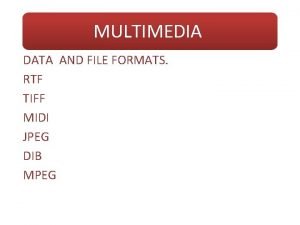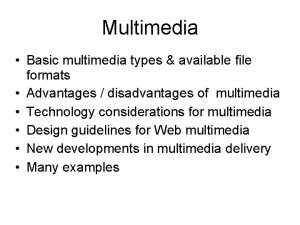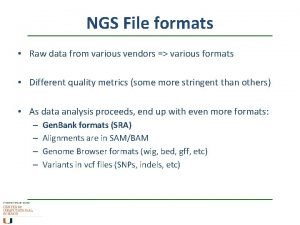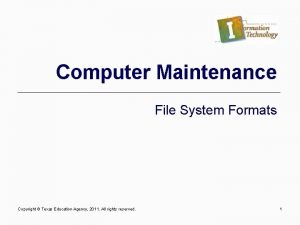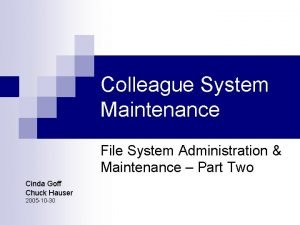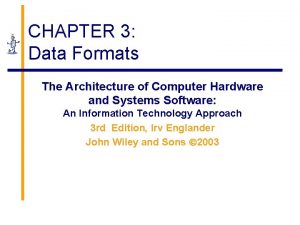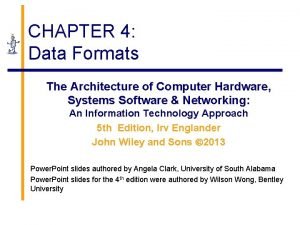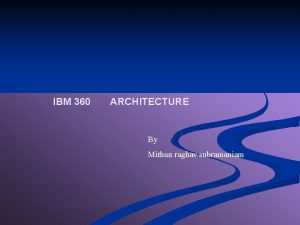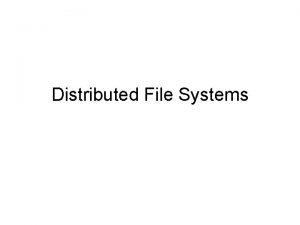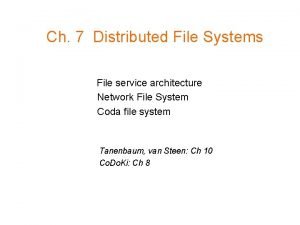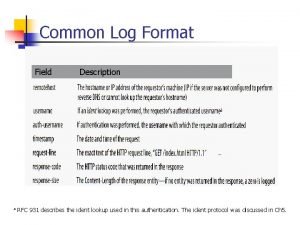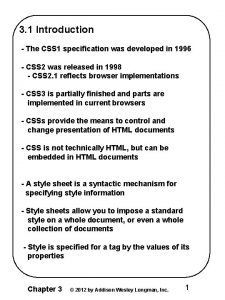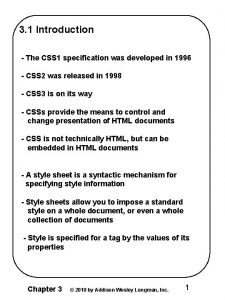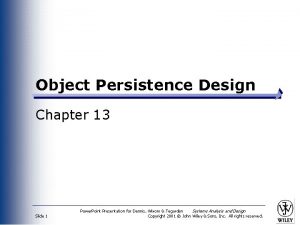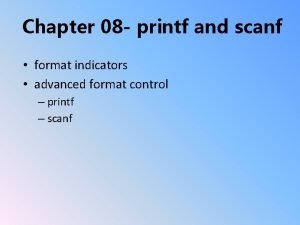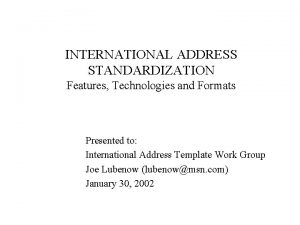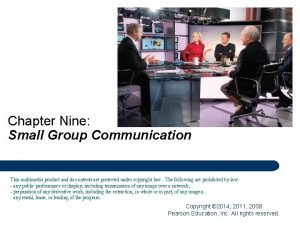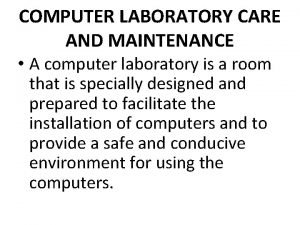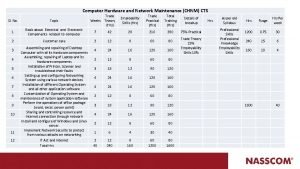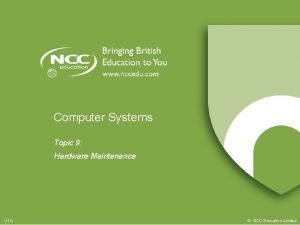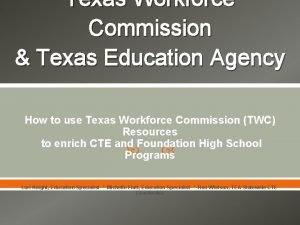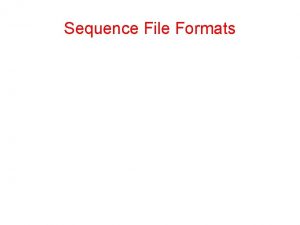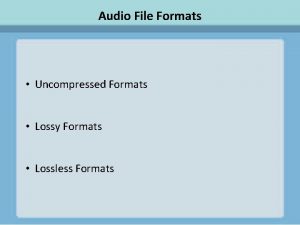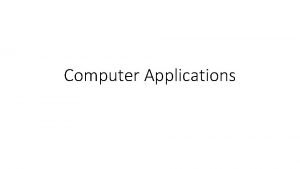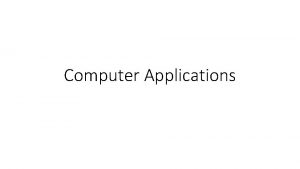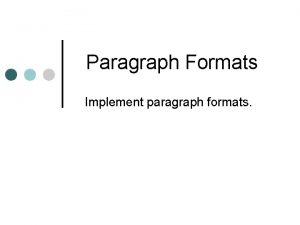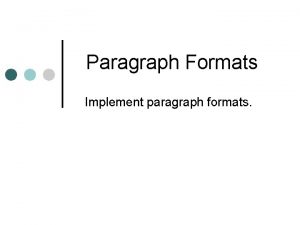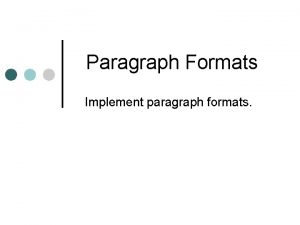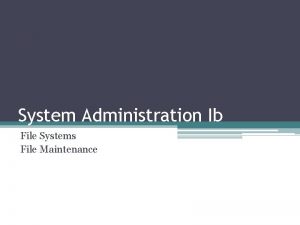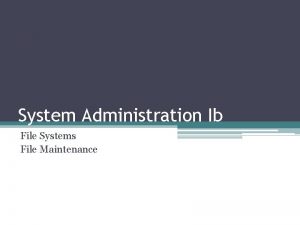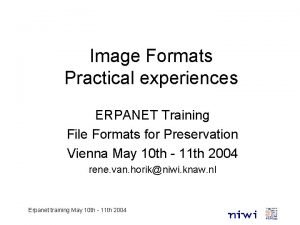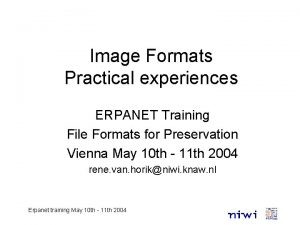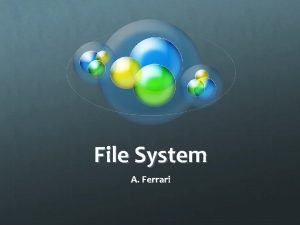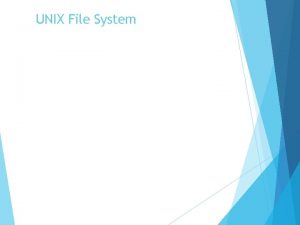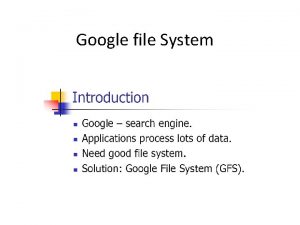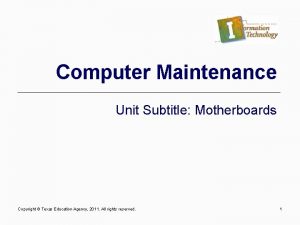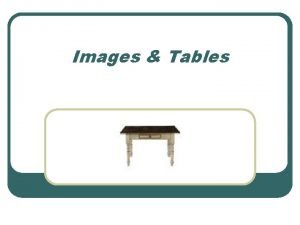Computer Maintenance File System Formats Copyright Texas Education










































































- Slides: 74

Computer Maintenance File System Formats Copyright © Texas Education Agency, 2011. All rights reserved. 1

What Is a File System? l The organizational method used by an OS to store files and folders on a secondary storage device l l l FAT (file allocation table) file system Files and directories File naming conventions File organization Partitions and logical drives on a hard drive Copyright © Texas Education Agency, 2011. All rights reserved. IT: Computer Maintenance File Systems 2

Partitions • Low level formatting is done at the factory. It marks off the disk into sectors and cylinders, and defines their placement on the disk. • FDISK is used to partition a hard drive (high level). Copyright © Texas Education Agency, 2011. All rights reserved. IT: Computer Maintenance File Systems 3

Partitions (cont. ) • When the hard drive is divided into more than one partition, the first partition is referred to as the primary partition and the second is called the extended partition. • The primary partition is usually the active partition, or the partition Windows refers to during the boot up process. • A hard disk can have up to 4 separate primary partitions, or 3 primary and 1 extended. Copyright © Texas Education Agency, 2011. All rights reserved. IT: Computer Maintenance File Systems 4

Partitions (cont. ) • Fat 16 can only address a maximum of 2 gigabytes (GB) of hard disk space. • FAT 32 increases the limit to 2 terabytes (TB) of hard disk space. • Only the primary partition on any hard drive can be designated as active. • DOS, Windows 95, and Windows 98 can only manage 1 primary partition per hard drive. • There can be only 1 extended partition per disk. Copyright © Texas Education Agency, 2011. All rights reserved. IT: Computer Maintenance File Systems 5

Partitions (cont. ) • Unlike the primary partition, it can be subdivided into a maximum of 23 sections called logical drives. • In Windows, in addition to the drive letter, each drive can be assigned a name called a drive label. The drive label can be up to 11 characters long. Copyright © Texas Education Agency, 2011. All rights reserved. IT: Computer Maintenance File Systems 6

Partitions and Logical Drives on a Hard Drive Copyright © Texas Education Agency, 2011. All rights reserved. IT: Computer Maintenance File Systems 7

About Clusters • Have you ever wondered what all those little boxes are when you defrag your hard drive? These boxes are clusters; they are storage units on the hard drive. • This applies mostly to the file systems FAT 12, FAT 16, and FAT 32. FAT Stands for file allocation table. • FAT 12 is only seen on floppy disks and very small storage media, while FAT 16 is the older version of FAT from the Windows 95 days, and FAT 32 is newer, from the Windows 98 days. • NT, 2000, XP, Vista, and Windows 7 can use all the FAT file systems, plus the NTFS (New Technology File System) Copyright © Texas Education Agency, 2011. All rights reserved. IT: Computer Maintenance File Systems 8

Files and Directories A hard drive is organized into groups of files stored in directories. The first directory is called the root directory. All directories can have child directories or sub directories. In Windows, a directory is called a folder. Copyright © Texas Education Agency, 2011. All rights reserved. IT: Computer Maintenance File Systems 9

Master Boot Record (MBR) The Master Boot Record, created when you create the first partition on the hard disk, is probably the most important data structure on the disk. It is the first sector on every disk. The location is always track (cylinder) 0, side (head) 0, and sector 1. The Master Boot Record contains the Partition Table for the disk and a small amount of executable code. Copyright © Texas Education Agency, 2011. All rights reserved. IT: Computer Maintenance File Systems 10

Master Boot Record (MBR) • On x 86 based computers, the executable code examines the Partition Table, and identifies the system partition. • The Master Boot Record then finds the system partition's starting location on the disk, and loads a copy of its Partition Boot Sector into memory. • The Master Boot Record then transfers execution to executable code in the Partition Boot Sector. Note: Although there is a Master Boot Record on every hard disk, the executable code in the sector is used only if the disk is connected to an x 86 -based computer and the disk contains the system partition. Copyright © Texas Education Agency, 2011. All rights reserved. IT: Computer Maintenance File Systems 11

Options for the Fdisk Command Copyright © Texas Education Agency, 2011. All rights reserved. IT: Computer Maintenance File Systems 12

Options for the Format Command Copyright © Texas Education Agency, 2011. All rights reserved. IT: Computer Maintenance File Systems 13

File Allocation Table FAT File System Copyright © Texas Education Agency, 2011. All rights reserved. IT: Computer Maintenance File Systems 14

FAT File System The File Allocation Table (FAT) file system is a simple file system originally designed for small disks and simple folder structures. The FAT file system is named for its method of organization, the file allocation table, which resides at the beginning of the volume. To protect the volume, two copies of the table are kept, in case one becomes damaged. In addition, the file allocation tables and the root folder must be stored in a fixed location so that the files needed to start the system can be correctly located. Copyright © Texas Education Agency, 2011. All rights reserved. IT: Computer Maintenance File Systems 15

FAT File System A volume formatted with the FAT file system is allocated into clusters. The default cluster size is determined by the size of the volume. For the FAT file system, the cluster number must fit in 16 bits and be a power of two. Copyright © Texas Education Agency, 2011. All rights reserved. IT: Computer Maintenance File Systems 16

How FAT Works The way FAT works is that it keeps a record at the start of the drive of all the files, and to point to the files, it points to the clusters that contain the files. The main rule of clusters is that there cannot be more than 1 file per cluster; otherwise, pointing to that cluster would cause problems, as it would be pointing and doing read/write operations on two files at once, which would cause Windows to crash. Depending on the size and FAT version of the partition, the cluster size can vary. Also keep in mind that a section of the partition is reserved for the FAT, which is the record of each file and where it can be found. This changes in size depending on the size of the partition and clusters. Copyright © Texas Education Agency, 2011. All rights reserved. IT: Computer Maintenance File Systems 17

FAT 32 File System • FAT 32 is a derivative of the File Allocation Table (FAT) file system that supports drives with over 2 GB of storage. Because FAT 32 drives can contain more than 65, 526 clusters, smaller clusters are used than on large FAT 16 drives. This method results in more efficient space allocation on the FAT 32 drive. • The largest possible file for a FAT 32 drive is 4 GB minus 2 bytes. • The FAT 32 file system includes four bytes per cluster within the file allocation table. Note that the high 4 bits of the 32 bit values in the FAT 32 file allocation table are reserved and are not part of the cluster number. Copyright © Texas Education Agency, 2011. All rights reserved. IT: Computer Maintenance File Systems 18

FAT Limitations Each FAT type has its limits; this table displays these limits: FAT type Max Clusters Cluster sizes Max volume size FAT 12 4, 086 0. 5 to 4 KB 16, 736, 256 bytes (16 MB) FAT 16 65, 526 2 KB to 32 KB 2, 147, 483, 648 bytes (2 GB) FAT 32 268, 435, 456 4 KB to 32 KB 8, 796, 093, 022, 208 bytes (8 TB) Copyright © Texas Education Agency, 2011. All rights reserved. IT: Computer Maintenance File Systems 19

FAT Relationships What is the maximum partition size of a FAT 16 drive? 2 GB How can you tell the type of partition used? Properties An HS is divided into what? Sectors Copyright © Texas Education Agency, 2011. All rights reserved. IT: Computer Maintenance File Systems 20

File System Types Showing FAT 16 in the HDD Properties Window Copyright © Texas Education Agency, 2011. All rights reserved. IT: Computer Maintenance File Systems 21

File System Types Showing FAT 32 in the HDD Properties Window Copyright © Texas Education Agency, 2011. All rights reserved. IT: Computer Maintenance File Systems 22

Converting FAT 16 to FAT 32 § At the command prompt: Cvt 1. exe § This will allow you to convert a FAT 16 file system to a FAT 32 system without losing any data. Converting FAT to NTFS § At the command prompt: Convert. exe § This will allow you to convert a FAT 16 or FAT 32 file system to a NTFS system without losing any data. Copyright © Texas Education Agency, 2011. All rights reserved. IT: Computer Maintenance File Systems 23

New Technology File System NTFS Copyright © Texas Education Agency, 2011. All rights reserved. IT: Computer Maintenance File Systems 24

NTFS System Files NTFS is a high performance, self healing file system proprietary to Windows XP and later. Features include • file level security, compression, and auditing • support for large volumes and powerful storage solutions such as built in RAID support • the ability to encrypt files and folders to protect your sensitive data • more efficient drive management due to its smaller cluster size capabilities • support for very large drives made possible by its 64 bit clustering arrangement • recoverable file system capabilities Copyright © Texas Education Agency, 2011. All rights reserved. IT: Computer Maintenance File Systems 25

NTFS System Files • In NTFS volumes, the data fields that follow the BIOS Parameter Block (BPB) form an extended BPB. • The data in these fields enables Ntldr (the NT loader program) to find the master file table (MFT) during startup. Copyright © Texas Education Agency, 2011. All rights reserved. IT: Computer Maintenance File Systems 26

NTFS System Files • In NTFS volumes, the MFT is not located in a predefined sector, as on FAT 16 and FAT 32 volumes. For this reason, the MFT can be moved if there is a bad sector in its normal location. • However, if the data is corrupted, the MFT cannot be located and Windows NT/2000 assumes that the volume has not been formatted. Copyright © Texas Education Agency, 2011. All rights reserved. IT: Computer Maintenance File Systems 27

Windows NT Partitions Copyright © Texas Education Agency, 2011. All rights reserved. IT: Computer Maintenance File Systems 28

NTFS System Files The Master File Table allocates a certain amount of space for each file record. The attributes of a file are written to the allocated space in the MFT. Small files and directories (typically 1500 bytes or smaller), such as the file illustrated in the next slide, can be entirely contained within the Master File Table record. Copyright © Texas Education Agency, 2011. All rights reserved. IT: Computer Maintenance File Systems 29

NTFS System Files This design makes file access very fast. Consider, for example, the FAT file system, which uses a file allocation table to list the names and addresses of each file. FAT directory entries contain an index into the file allocation table. When you want to view a file, FAT first reads the file allocation table and assures that it exists. Then FAT retrieves the file by searching the chain of allocation units assigned to the file. With NTFS, as soon as you look up the file, it's there for you to use. Copyright © Texas Education Agency, 2011. All rights reserved. IT: Computer Maintenance File Systems 30

The Organization of an NTFS Disk Volume Copyright © Texas Education Agency, 2011. All rights reserved. IT: Computer Maintenance File Systems 31

Basic NTFS Master File Table Record Copyright © Texas Education Agency, 2011. All rights reserved. IT: Computer Maintenance File Systems 32

Master File Table The Master File Table (MFT) replaces the FAT in an MS DOS compatible system and contains information about each file being stored on the disk. In order of occurrence, this information includes: • Header information • Standard information • Filename • Security information • Data Copyright © Texas Education Agency, 2011. All rights reserved. IT: Computer Maintenance File Systems 33

The system files produced during the NTFS formatting process include: 0/1. A pair of MFT files (the real one and a shorter backup version) 2. A log file to maintain transaction steps for recovery purposes 3. A volume file that includes the volume name, NTFS version, and other key volume information 4. An attribute definition table file 5. A root filename file that serves as the drive’s root folder Copyright © Texas Education Agency, 2011. All rights reserved. IT: Computer Maintenance File Systems 34

The system files produced during the NTFS formatting process include: 6. A cluster bitmap that represents the volume and shows which clusters are in use 7. The partition boot sector file 8. A bad cluster file containing the locations of all bad sectors identified on the disk 9. A quota table for tracking allowable storage space on the disk for each user 10. An upper case table for converting lowercase characters to Unicode uppercase characters Copyright © Texas Education Agency, 2011. All rights reserved. IT: Computer Maintenance File Systems 35

NTFS File Compression Windows NT/2000 supports compression on individual files, folders, and entire NTFS volumes. Files compressed on an NTFS volume can be read and written by any Windows based application without first being decompressed by another program. Copyright © Texas Education Agency, 2011. All rights reserved. IT: Computer Maintenance File Systems 36

NTFS File Encryption The Encrypting File System (EFS) provides the core file encryption technology used to store encrypted files on NTFS volumes. EFS keeps files safe from intruders who might gain unauthorized physical access to sensitive, stored data (for example, by stealing a portable computer or external disk drive). Copyright © Texas Education Agency, 2011. All rights reserved. IT: Computer Maintenance File Systems 37

NTFS File Encryption is transparent to the user who encrypted the file; the system automatically decrypts the file or folder when the user accesses it. When the file is saved, encryption is reapplied. Users who are not authorized to access the encrypted files or folders transparently receive an “Access denied” message if they try to open, copy, move, or rename the encrypted file or folder. Copyright © Texas Education Agency, 2011. All rights reserved. IT: Computer Maintenance File Systems 38

NTFS File Encryption Users can invoke EFS features through Windows Explorer or by using a command line utility called cipher. exe. To use Windows Explorer to encrypt a file, open the File Property Window by right clicking on the file name. Click Advanced. . . The Advanced Attributes dialog will be opened, allowing you to mark the file as encrypted. Copyright © Texas Education Agency, 2011. All rights reserved. IT: Computer Maintenance File Systems 39

NTFS File Encryption • Before saving new settings Windows will prompt the user to encrypt only the file or the whole folder. It address a very important issue while the file itself could be perfectly protected, the application which opens the file may create temporary copies of the file while working with the document. • The example is Microsoft Word. When the user opens an encrypted document, EFS decrypts it transparently for Word. Then during the work, Word creates a temporary hidden file where it automatically saves the document in the process of editing, and deletes it on the exit. This hidden file presents a real breach in security because it contains user data in plain (not encrypted) form. Encrypting the whole folder instead of only the file solves this problem. Copyright © Texas Education Agency, 2011. All rights reserved. IT: Computer Maintenance File Systems 40

NTFS File Encryption Copyright © Texas Education Agency, 2011. All rights reserved. IT: Computer Maintenance File Systems 41

NTFS Cluster Sizes Copyright © Texas Education Agency, 2011. All rights reserved. IT: Computer Maintenance File Systems 42

NTFS Security l The Windows NT file system provides security for each file in the system, as well as supplying complete file access auditing information to the system administrator. NTFS files and folders can have permissions assigned to them whether they are shared or not. l The NTFS system includes security features that enable permission levels to be assigned to files and folders on the disk. These permissions set parameters for activities that users can conduct with the designated file or folder. Copyright © Texas Education Agency, 2011. All rights reserved. IT: Computer Maintenance File Systems 43

NTFS File Attributes Standard NTFS permissions include: • Read (R) This permission enables the file or folder to be displayed along with its attributes and permissions. • Write (W) This permission enables the user to add files or folders, change file and folder attributes, add data to an existing file, and change display attributes. • Execute (X) – This permission enables users to make changes to subfolders, display attributes and permissions, as well as to run executable file types. Copyright © Texas Education Agency, 2011. All rights reserved. IT: Computer Maintenance File Systems 44

NTFS File Attributes (cont. ) • Delete (D) – This permission makes it possible for users to remove files and folders. • Change Permission (P) This permission enables users to change permission assignments for files and folders. • Take Ownership (O) – This permission enables the user to take ownership of the file or folder. Copyright © Texas Education Agency, 2011. All rights reserved. IT: Computer Maintenance File Systems 45

NTFS Files Attributes Some combinations of the permissions are woven together in Standard NTFS file and folder permissions. These include: • No Access (none). File and Folder level • Read (RX). File and Folder level • Change (RWXD). File and Folder level • Add (WX). Folder level only • Add & Read (RWX). Folder level (RX) File level • List (RX). Folder level only • Full Control (RWXDPO). File and Folder level Copyright © Texas Education Agency, 2011. All rights reserved. IT: Computer Maintenance File Systems 46

NTFS 5 • Windows 2000 and up features an improved NTFS, referred to as NTFS 5 and NTFS 6. These versions enable administrators to establish user hard disk quotas limiting the amount of hard drive space users can have access to. • The NTFS system also offers enhanced system security. • Windows 2000+ provides an encrypted file system and secure network protocol and authentication standards. Copyright © Texas Education Agency, 2011. All rights reserved. IT: Computer Maintenance File Systems 47

Disk Quotas § Limit how much disk space a user can access § Do not specify the locations of files, just the total space allowed § Can be set only if you are using NTFS Copyright © Texas Education Agency, 2011. All rights reserved. IT: Computer Maintenance File Systems 48

Windows Volumes Windows allows you to choose between two types of logical disks: Basic or Dynamic There are five different types of dynamic volumes: • • • Simple Spanned Mirrored Striped RAID 5 Copyright © Texas Education Agency, 2011. All rights reserved. IT: Computer Maintenance File Systems 49

Basic Disks Before Win 2 K, Windows operating systems used only basic disks which date back to Windows 9 x and have a fairly respectable past. Microsoft designed the basic disk to support future Windows products. In essence, a basic disk contains basic volumes such as primary partitions, extended partitions, and logical drives. Copyright © Texas Education Agency, 2011. All rights reserved. IT: Computer Maintenance File Systems 50

Basic Disks When you use basic disks, you're limited to creating four primary partitions per disk, or three primary partitions and one extended partition with unlimited logical drives. Copyright © Texas Education Agency, 2011. All rights reserved. IT: Computer Maintenance File Systems 51

Basic Disks l Although these limitations are real, they aren't as severe as you might think. Basic and dynamic disks differ in the number of partitions (on basic disks) and volumes (on dynamic disks) that each can contain. l Basic disks also use the partition tables (stored in the Master Boot Record at the beginning of the disk) that Windows XP, Win 2 K, NT 4. 0, Windows Me, Win 9 x, and MS DOS support. Copyright © Texas Education Agency, 2011. All rights reserved. IT: Computer Maintenance File Systems 52

Basic Disks To make matters more confusing, basic disk volumes also include support for multidisk volumes—such as volume sets, stripe sets, mirror sets, and stripe sets with parity— created in NT 4. 0 or earlier (XP doesn't support these multidisk basic volumes but Win 2 K does). Copyright © Texas Education Agency, 2011. All rights reserved. IT: Computer Maintenance File Systems 53

Dynamic Disks The limitations of basic disks and other inconveniences drove the creation of a new type of disk definition for Windows systems, the dynamic disk. Windows XP Professional Edition and Win 2 K support dynamic disk storage. When you initialize a physical disk as dynamic, it's called a dynamic disk and contains dynamic volumes, such as simple volumes, spanned volumes, striped volumes, mirrored volumes, and RAID 5 volumes. Copyright © Texas Education Agency, 2011. All rights reserved. IT: Computer Maintenance File Systems 54

Dynamic Disks l l Dynamic disk storage is divided into volumes instead of partitions. Dynamic storage lets you manage disks and volumes without restarting Windows. Differentiating storage types (i. e. , basic and dynamic disks) from file system types (i. e. , FAT, FAT 16, FAT 32, and NTFS), and from partitions and volumes is important. Storage types are different from file system types. Copyright © Texas Education Agency, 2011. All rights reserved. IT: Computer Maintenance File Systems 55

Dynamic Disks l l On a basic disk, a partition is a portion of the disk that functions as a physically separate unit. A physical disk unit can contain any combination of storage types. However, all volumes on the same disk must use the same storage type. A volume is a storage unit derived from free space on one or more dynamic disks. You can format both partitions and volumes with a file system (such as NTFS) and assign a drive letter. Volumes also have different layouts (e. g. , simple, spanned, striped) and characteristics. Copyright © Texas Education Agency, 2011. All rights reserved. IT: Computer Maintenance File Systems 56

Dynamic Disks Basic disks used to provide different layout types (e. g. , spanned, mirrored, RAID 5) with partitions. However, XP Pro, Win 2 K, and the Win. NET Server provide these layouts in dynamic disk volumes. Unfortunately, laptop computers and XP Home Edition based computers don't support dynamic disks. Copyright © Texas Education Agency, 2011. All rights reserved. IT: Computer Maintenance File Systems 57

Dynamic Disks Other dynamic disk limitations include a lack of support for removable storage devices (i. e. , IEEE 1394 Fire. Wire and USB attached disks) Copyright © Texas Education Agency, 2011. All rights reserved. IT: Computer Maintenance File Systems 58

Dynamic Disks Dynamic disks introduced the concept of disk groups. VERITAS Software has performed a lot of storage management work for Microsoft, and VERITAS's Logical Disk Manager (LDM) Pro for Windows heavily uses disk groups. Copyright © Texas Education Agency, 2011. All rights reserved. IT: Computer Maintenance File Systems 59

Dynamic Disks Disk groups (collections of disks organized as entities) help administrators prevent data loss by organizing dynamic disks. All dynamic disks within a disk group store configuration data for the entire group (this data is stored in a 1 MB region at the end of each dynamic disk). Copyright © Texas Education Agency, 2011. All rights reserved. IT: Computer Maintenance File Systems 60

Dynamic Disks l l All configuration information for simple, spanned, mirrored, striped, or RAID 5 volumes within a disk group is stored on each disk in the group. This "database" of configuration information is replicated and kept up to date across all dynamic disks in the group. If you lose a dynamic disk or you move the disk group to another system, the OS maintains the configuration information for the disk group. Copyright © Texas Education Agency, 2011. All rights reserved. IT: Computer Maintenance File Systems 61

Dynamic Disks Win 2 K systems allow only one disk group (Disk Group 0—DG 0) per computer (unless you use LDM Pro). Microsoft will probably extend this disk group functionality in future Windows releases. Copyright © Texas Education Agency, 2011. All rights reserved. IT: Computer Maintenance File Systems 62

Disk Management To open Disk Management 1. Click Start, and then Control Panel 2. Click Performance and Maintenance 3. Click Administrative Tools 4. Double click Computer Management 5. In the console tree, click Disk Management Copyright © Texas Education Agency, 2011. All rights reserved. IT: Computer Maintenance File Systems 63

Disk Management l l You must be logged on as an administrator or a member of the Administrators group in order to complete this procedure. If your computer is connected to a network, network policy settings may also prevent you from completing this procedure. You cannot format the system or boot partition. Compression is supported only on NTFS volumes. Quick Format removes files from the disk, but does not scan the disk for bad sectors. Use this option only if this disk has been previously formatted and you are sure the disk is not damaged. Copyright © Texas Education Agency, 2011. All rights reserved. IT: Computer Maintenance File Systems 64

Partition Recovery Concepts As an example we'll use the following disk layout: Here we have two primary partitions (C: and H: ), and one extended that has two logical drives (D: and E: ). Copyright © Texas Education Agency, 2011. All rights reserved. IT: Computer Maintenance File Systems 65

NTFS vs. FAT Criteria Operating System NTFS 5 NTFS Windows NT, 2000, Windows XP Copyright © Texas Education Agency, 2011. All rights reserved. FAT 32 FAT 16 Windows 98, Windows ME, Windows 2000, Windows XP DOS, All versions of Microsoft Windows IT: Computer Maintenance File Systems 66

NTFS vs. FAT Criteria NTFS 5 NTFS FAT 32 FAT 16 Limitations Max Volume Size 256 TB 2 TB 2 GB Max Files on Volume Nearly Unlimited ~65000 Max File Size Limited by Volume Size 4 GB 2 GB Max Clusters Number Nearly Unlimited 268435456 65535 Max File Name Length Up to 255 characters Standard – 8. 3 Extended – up to 255 Copyright © Texas Education Agency, 2011. All rights reserved. IT: Computer Maintenance File Systems 67

NTFS vs. FAT Criteria NTFS 5 NTFS FAT 32 FAT 16 File System Features Unicode File Names System Records Mirror Unicode Character Set System Character Set MFT Mirror File Second Copy of FAT Boot Sector Location First and Last Sectors First Sector File Attributes Standard and Custom Standard Set Alternate Streams Yes No No Compression Yes No No Copyright © Texas Education Agency, 2011. All rights reserved. IT: Computer Maintenance File Systems 68

NTFS vs. FAT Criteria NTFS 5 NTFS FAT 32 FAT 16 File System Features Encryption Yes No No No Object Permissions Yes No No Disk Quotas Yes No No No Sparse Files Yes No No No Reparse Points Yes No No No Volume Mount Points Yes No No No Copyright © Texas Education Agency, 2011. All rights reserved. IT: Computer Maintenance File Systems 69

NTFS vs. FAT Criteria NTFS 5 NTFS FAT 32 FAT 16 Overall Performance Built In Security Yes No No Recoverability Yes No No Performance Low on small volumes, High on Large Low on small volumes, High on Large High on small volumes, Low on large Highest on small volumes, Low on large Disk Space Economy Max Average Minimal on large volumes Fault Tolerance Max Minimal Average Copyright © Texas Education Agency, 2011. All rights reserved. IT: Computer Maintenance File Systems 70

Partition Recovery Copyright © Texas Education Agency, 2011. All rights reserved. IT: Computer Maintenance File Systems 71

Partition Recovery Concepts For the machine to be able to start booting properly, the following conditions should apply: • The Master Boot Record (MBR) exists and is safe. • The Partition Table exists and contains at least one active partition. • If so, the executable code in the MBR selects an active partition and passes control there; thus it can start loading proper files (COMMAND. COM, NTLDR, . . . ) depending on the file system type in that partition. However, if these files are missing or corrupted then the OS will be unbootable – remember the famous error "NTLDR is missing. . . " ? Copyright © Texas Education Agency, 2011. All rights reserved. IT: Computer Maintenance File Systems 72

Partition Recovery Concepts For the partition/drive to be visible to the Operating System, the following conditions should apply: • The Partition/Drive can be found via Partition Table • The Partition/Drive boot sector is safe • If so, the OS can read the partition/drive parameters and display the drive in the list of the available drives. However, if the file system itself is damaged (Root, FAT area on FAT 12/FAT 16/FAT 32, or system MFT records on NTFS), the drive's content might not be displayed and we might see errors like "MFT is corrupted“ or "Drive is invalid. " Copyright © Texas Education Agency, 2011. All rights reserved. IT: Computer Maintenance File Systems 73

Partition Recovery Concepts • The simplest way to repair or re create the MBR is to run Microsoft's standard utility called FDISK with a parameter /MBR, like A: > FDISK. EXE /MBR (This is a standard utility that is included with MS DOS, Win 95, Win 98, and Win. ME) • If you have Windows NT / 2000 / XP, you can boot from the startup floppy disks or CD ROM; choose the repair option during setup, and run Recovery Console. When you are logged on, you can run the FIXMBR command to fix the MBR. Copyright © Texas Education Agency, 2011. All rights reserved. IT: Computer Maintenance File Systems 74
 File-file yang dibuat oleh user pada jenis file di linux
File-file yang dibuat oleh user pada jenis file di linux Windows movie maker 2012 download
Windows movie maker 2012 download File formats in multimedia
File formats in multimedia File formats in multimedia
File formats in multimedia Html
Html Ngs file formats
Ngs file formats Hadoop file formats
Hadoop file formats File system
File system File system maintenance
File system maintenance Computer data format
Computer data format Data formats in computer architecture
Data formats in computer architecture Distributed file system
Distributed file system In a file-oriented information system, a transaction file
In a file-oriented information system, a transaction file Ibm 360 instruction set
Ibm 360 instruction set Difference between logical file and physical file
Difference between logical file and physical file File sharing management system
File sharing management system An html file is a text file containing small markup tags.
An html file is a text file containing small markup tags. Pearson education ltd
Pearson education ltd 2017 pearson education inc
2017 pearson education inc Copyright 2010 pearson education inc
Copyright 2010 pearson education inc Copyright 2009
Copyright 2009 Copyright pearson education inc
Copyright pearson education inc 2014 pearson education inc
2014 pearson education inc Copyright 2010 pearson education inc
Copyright 2010 pearson education inc Copyright 2010 pearson education inc
Copyright 2010 pearson education inc Copyright by pearson education inc. answers
Copyright by pearson education inc. answers Copyright 2003 pearson education inc
Copyright 2003 pearson education inc Copyright 2009 pearson education inc
Copyright 2009 pearson education inc Copyright pearson education inc
Copyright pearson education inc Copyright 2010 pearson education inc
Copyright 2010 pearson education inc Copyright 2010 pearson education inc
Copyright 2010 pearson education inc Copyright 2010 pearson education inc
Copyright 2010 pearson education inc Copyright 2010 pearson education inc
Copyright 2010 pearson education inc Copyright 2010 pearson education inc
Copyright 2010 pearson education inc Composition copyright example
Composition copyright example Copyright 2010 pearson education inc
Copyright 2010 pearson education inc Copyright 2009 pearson education inc
Copyright 2009 pearson education inc Copyright 2009 pearson education inc
Copyright 2009 pearson education inc 2009 pearson education inc
2009 pearson education inc Copyright 2009 pearson education inc
Copyright 2009 pearson education inc Copyright pearson education inc
Copyright pearson education inc File system modules in distributed system
File system modules in distributed system Architecture of distributed file system
Architecture of distributed file system File system in operating system
File system in operating system File system in operating system
File system in operating system File system in operating system
File system in operating system Compare stl and slc file format
Compare stl and slc file format Map reduce types
Map reduce types Input formats in hadoop
Input formats in hadoop What's a couplet poem
What's a couplet poem Common log format
Common log format Business writing formats
Business writing formats Simplified format of business letter
Simplified format of business letter Radio station music formats
Radio station music formats Objectives of business letter
Objectives of business letter Style specification formats
Style specification formats Action recipe
Action recipe Style specification formats
Style specification formats Object persistence formats
Object persistence formats Object persistence formats
Object persistence formats Scanf formats
Scanf formats International address formats
International address formats Camtasia 9 codec
Camtasia 9 codec Small group stages formats and culture
Small group stages formats and culture Computer laboratory rules and regulations
Computer laboratory rules and regulations Chnnm
Chnnm Types of computer hardware maintenance
Types of computer hardware maintenance Explain the components of computer system
Explain the components of computer system Difference between a computer and computer system
Difference between a computer and computer system Board of professional engineers texas
Board of professional engineers texas Dccr texas education agency
Dccr texas education agency Sela texas education agency
Sela texas education agency Texas education agency jobs
Texas education agency jobs Texas women in higher education
Texas women in higher education Teds esc
Teds esc


